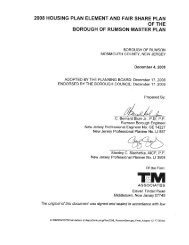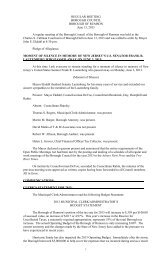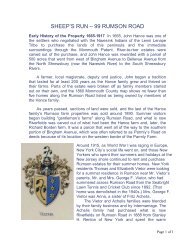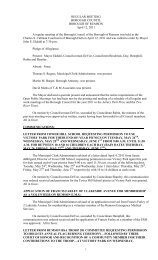Emergency Procedures Manual - Rumson Borough
Emergency Procedures Manual - Rumson Borough
Emergency Procedures Manual - Rumson Borough
Create successful ePaper yourself
Turn your PDF publications into a flip-book with our unique Google optimized e-Paper software.
BOROUGH OF RUMSON<br />
EMERGENCY<br />
MANAGEMENT<br />
GUIDE FOR<br />
FAMILY RESPONSE TO<br />
EMERGENCY SITUATIONS<br />
Mark Rubin - <strong>Emergency</strong> Management Coordinator
INTRODUCTION<br />
BE READY, BE SAFE, BE PREPARED<br />
ARE YOU READY?<br />
Disasters can happen anytime in <strong>Rumson</strong>, whether it is a snowstorm, flooding, or<br />
chemical spill. You can’t always avoid them, but being prepared can help lessen the effects of<br />
these events on you, your family or your business.<br />
Preparing for disaster can be as simple as buying extra water or batteries during a trip to<br />
the grocery store, but there are many more steps you can and should take to ensure that you<br />
don’t fall victim to a disaster.<br />
1. Get a kit of emergency supplies that will allow you and your family to survive for at least 3<br />
days in the event of an emergency. The kit should include basic items like water, food,<br />
battery powered radio, an extra battery and car charging kit for your cell phone, flashlights<br />
and a first-aid kit.<br />
2. Make a plan—plan in advance what you and your family will do in an emergency. Your<br />
plan should include a communications plan and address sheltering in place and evacuation<br />
information.<br />
3. Be informed—learn more about different threats that could affect your community and<br />
appropriate responses to them.<br />
4. Get involved—after preparing yourself and your family for possible emergencies, take the<br />
next step: get training in first aid and emergency response, and get involved in preparing<br />
your community. If you want to read more on the subject, pick up a free copy of the FEMA<br />
<strong>Manual</strong> “Are You Ready?” at Police Headquarters.<br />
-2-
OFFICE OF EMERGENCY MANAGEMENT<br />
MISSION STATEMENT<br />
The mission of the <strong>Borough</strong> of <strong>Rumson</strong> Office of <strong>Emergency</strong> Management (OEM) is to<br />
maintain a high level of preparedness, to protect the citizens of the <strong>Borough</strong> of <strong>Rumson</strong>;<br />
to mitigate loss of life and vital assets prior to, during, and in the immediate aftermath<br />
of a disaster; and to facilitate the speedy recovery of the borough in the mid- and longterm<br />
intervals following a disaster.<br />
OEM has the statutory responsibility to coordinate all borough emergency response<br />
plans. OEM's responsibilities are to identify vulnerabilities, effectively mitigate<br />
disasters, provide public education, respond to all hazard-emergency situations, protect<br />
the borough's first responders, ensure continuity of government and business, and to<br />
facilitate an effective recovery. OEM will coordinate with local, state, and federal<br />
agencies, as well as private entities to develop, maintain, and implement the <strong>Emergency</strong><br />
Operations Plan (EOP).<br />
OEM is prepared to activate an <strong>Emergency</strong> Operations Center during any major<br />
disaster to allow coordination of all support agencies to provide continuity of services<br />
to the public.<br />
-3-
EMERGENCY NUMBERS<br />
During the event of an imminent or actual emergency, guidance will be available to you<br />
via the radio, TV, newspapers, internet and through Police and Fire services. At that time,<br />
please cooperate by not overloading the telephone lines unless you feel it is absolutely<br />
necessary to call for aid or must report a serious situation. Monitor the AM <strong>Emergency</strong> Radio<br />
frequency (1630 kHz. on your AM radio), the borough’s website, and local radio stations for<br />
current information.<br />
Keep a list of emergency numbers, including:<br />
POLICE, FIRE, MEDICAL EMERGENCIES………………. 732-842-0500 (or Dial 911)<br />
<strong>Borough</strong> Hall (Other than to report an emergency) ……… 732-842-3300<br />
Local OEM <strong>Emergency</strong> Management Coordinator………. 732-842-0500<br />
FAMILY EMERGENCY PREPAREDNESS ACTIONS<br />
CREATE A DISASTER PLAN<br />
Discuss the types of disasters that are most likely to happen, learn your community’s warning<br />
signals, and what you should do when you hear them.<br />
PICK TWO PLACES TO MEET:<br />
1. Right outside your home in case of a sudden emergency, like a fire.<br />
2. Outside your neighborhood in case you can’t return home (everyone must know the address<br />
and phone number).<br />
* Establish an out-of-state friend to act as a contact for separated family members.<br />
* Show each member of the household how to turn off water, gas and electricity, and<br />
consider neighbors who may need assistance.<br />
* Monitor weather conditions on NOAA Weather Radio – 162.550 MHz. (This is also<br />
broadcast on the AM <strong>Emergency</strong> Radio frequency 1630 kHz.)<br />
* Install smoke detectors on each level of your home, check batteries regularly and<br />
change them twice a year.<br />
* Find out where children will be sent if they are in school when an evacuation is<br />
announced.<br />
-4-
COMPLETE THIS CHECKLIST<br />
Post emergency telephone numbers by phones.<br />
Teach your children how and when to call 911 or your local police (732-842-0500) for<br />
emergency help.<br />
Check if you have adequate insurance coverage.<br />
Teach each family member how to use the fire extinguisher and show them where it is<br />
kept.<br />
Install smoke detectors on each level of your home, especially near bedrooms.<br />
Conduct a home hazard hunt.<br />
Take a Red Cross First Aid and CPR class.<br />
Determine the best escape route from your home. Find two ways out of each room.<br />
Find the safe spots in your home for each type of disaster.<br />
PUT TOGETHER A DISASTER SUPPLY KIT<br />
- Prescription medications and medical information.<br />
- Special dietary food if required.<br />
- First aid kits—one for your home and one for your car.<br />
- Lantern, flashlight, or other emergency lighting.<br />
- Food that doesn’t need to be cooked.<br />
- Rotate stored food every six months.<br />
- Personal aids, eyeglasses, hearing aids, etc.<br />
- Insurance information.<br />
- Portable radio and extra batteries (for cell phone, too).<br />
- Baby supplies such as food, formula, disposable diapers, etc.<br />
- Water in plastic jugs or other covered containers—change water every three months.<br />
- A change of clothing, rain gear and sturdy shoes.<br />
- Blankets or sleeping bags.<br />
Store the supplies in an easy-to-carry container such as a backpack or duffle bag.<br />
-5-
EVACUATION<br />
1. FOLLOW THE INSTRUCTIONS AND ADVICE OF YOUR LOCAL GOVERNMENT<br />
If you are advised to evacuate, do so promptly. If you are instructed to move to a certain<br />
location, go there—don’t go anywhere else.<br />
2. SECURE YOUR HOME BEFORE LEAVING<br />
If you have time, and if you have not received other instructions from your local<br />
government, you should take the following actions before leaving home:<br />
a. Bring outside possessions inside the house, or tie them down securely.<br />
b. Disconnect any electrical appliances or equipment that cannot be removed—but do<br />
not touch them if you are wet or standing in water.<br />
c. Lock house doors and windows.<br />
3. TRAVEL WITH CARE<br />
a. Leave early enough to avoid being marooned by flooded roads.<br />
b. Make sure you have enough gasoline in your car.<br />
c. Follow the recommended routes.<br />
d. As you travel, keep listening to the radio for additional information and instructions<br />
from your local government.<br />
e. Watch for washed-out or undermined roadways, earth slides, broken sewer or water<br />
mains, loose or downed electric wires and falling or fallen objects.<br />
f. Watch out for areas where rivers or streams may flood suddenly.<br />
g. Don’t try to cross a stream or a pool of water unless you are certain that the water<br />
will not be over your knees, or above the middle of the car’s wheels, all the way<br />
across. If you decide it is safe to drive across it, put your car in low gear and drive<br />
very slowly to avoid splashing water into your engine causing it to stop. Also,<br />
remember that your brakes may not work well after the wheels of your car have been<br />
deep in water. Try them out a few times when you reach the other side.<br />
-6-
HURRICANES<br />
It is very important that you listen to the recommendations of the emergency management<br />
office and immediately take the action they recommend.<br />
<strong>Emergency</strong> information will be broadcast on local radio and television stations, leave areas<br />
early that might be affected by storm surge flooding.<br />
LEAVE WHEN ADVISED TO DO SO BY LOCAL OFFICIALS<br />
A HURRICANE WATCH is issued for a coastal area when there is a threat of hurricane<br />
conditions within 24-36 hours. It means you must take action to obtain supplies, secure your<br />
home and prepare to evacuate.<br />
A HURRICANE WARNING is issued when hurricane conditions of strong wind, high water<br />
and storm surge are expected in specified coastal areas in 24 hours or it means you must take<br />
action for your safety.<br />
PRE-EVACUATION ACTIONS<br />
- Fill your car with gas, check car battery and oil, flashlight and radio batteries.<br />
- Put your disaster supply kit together and be prepared to take it with you. Secure outdoor<br />
lawn furniture and other loose materials, shutter windows, etc.<br />
- Prepare your family for evacuation. Because it depends on the strength, location and<br />
direction of the hurricane’s movement, you may have to evacuate even before a hurricane<br />
warning is issued.<br />
- If you are going to a designated public shelter, take blankets or sleeping bags.<br />
- Top off underground tanks to prevent floatation.<br />
- Make arrangements for your pets. They may not be allowed in public shelters.<br />
- Remember, late evacuations will take longer to clear the threatened area—evacuate early<br />
and promptly.<br />
- Stay tuned for emergency information on local radio, TV and Cable stations.<br />
-7-
FLOODS<br />
The National Oceanic and Atmospheric Administration issues flood forecasts and warnings<br />
when rainfall is enough to cause rivers to overflow their banks or when melting snow combines<br />
with rainfall to produce similar effects.<br />
Flood Warnings are forecasts of impending floods that are given by radio and television and<br />
through local government emergency forces. Careful preparations and prompt response will<br />
ensure personal safety and reduce property loss.<br />
BEFORE THE FLOOD<br />
1. Flood insurance is available in participating communities through the federally sponsored<br />
National Flood Insurance Program. Contact your local licensed insurance broker or agent for<br />
more information.<br />
2. Find out how many feet your property is above or below possible flood levels; when<br />
predicted flood levels are broadcast, you can determine if you may be flooded.<br />
3. Keep stock of food which requires no cooking or refrigeration. Regular electric and gas<br />
service may be disrupted.<br />
4. Keep a portable radio, emergency cooking equipment, and flashlights in working order;<br />
stock extra batteries.<br />
5. Keep first aid supplies and any medicines needed by members of your family.<br />
6. Keep your automobile fueled.<br />
7. Store drinking water in closed, clean containers. Water service may be interrupted.<br />
8. If flooding is likely and time permits, move essential items and furniture to the upper floors<br />
of your house. Disconnect any electrical appliances that can’t be moved—but don’t touch<br />
them if you are wet or standing in water.<br />
AFTER THE FLOOD<br />
1. Do not use fresh food that has come in contact with flood waters.<br />
2. Do not visit the disaster area. Your presence will probably hamper rescue and other<br />
emergency operations.<br />
3. Do not handle live electrical equipment in wet area. Electrical equipment should be checked<br />
and dry before returning it to service.<br />
4. Use battery-powered lanterns or flashlights, not oil or gas lanterns or torches to examine<br />
buildings. Flammables may be inside.<br />
5. Report broken utility lines to police or other appropriate authorities.<br />
6. Keep tuned to your local radio or television station for advice or instructions from your local<br />
government.<br />
7. Notify your insurance agent or broker if your property was damaged by the flood.<br />
-8-
FIRES<br />
Fire safety rules are of special importance in an emergency, but also should be observed every<br />
day to prevent disaster.<br />
Most fire deaths occur in the home. There is one low-cost, easily obtainable device which has<br />
proven itself in saving lives; a smoke detector. Deaths from fire in the home have been<br />
substantially reduced when smoke detectors were present.<br />
A smoke detector should be placed as close as possible to bedrooms. It is always a good idea to<br />
install a smoke detector on each level near stairways to the rest of the house. Smoke detectors<br />
should be checked and maintained regularly. Each member of your family should know what<br />
to do if the smoke detector goes off. A little time spent selecting escape routes and practicing<br />
what to do may save lives if a fire occurs in your home. Agree on a plan to meet outside so you<br />
can be sure everyone gets out of the house safely.<br />
TO KEEP FIRES FROM STARTING<br />
1. Clean out attics, basements, closets and garages frequently. Don’t let trash and “junk”<br />
accumulate.<br />
2. Extension cords should not be overloaded. Checks cords often for fraying and avoid running<br />
them under rugs. An extension cord used to connect an appliance should always be the<br />
proper size and capacity for the appliance.<br />
3. Store flammable liquids in approved containers outside the home if possible. Never use<br />
gasoline, naptha, and similar liquids indoors – their fumes will readily ignite from any kind<br />
of spark. Rags soaked with cleaning fluid or turpentine sometimes catch fire by themselves<br />
(this is called spontaneous combustion), and they should be safely discarded after use. Also,<br />
never smoke while handling flammable liquids.<br />
4. Check your home’s heating sources. Many home fires are started by faulty furnaces and<br />
stoves, cracked or rusted furnace parts, and chimneys with creosote build-up. Be sure<br />
whatever heating source you use is clean and in good working order.<br />
5. When stoves or heaters have an open flame, keep them away from walls, furniture, draperies<br />
and other flammable items and place a screen in front of the flame.<br />
-9-
WINTER STORMS<br />
Severe winter weather can dramatically increase seasonal deaths and injuries.<br />
A. KEEP POSTED ON WEATHER CONDITIONS<br />
1. A BLIZZARD is the most dangerous of all winter storms. It combines cold air, heavy<br />
snow and strong winds that blow the snow about and may reduce visibility to only a<br />
few yards.<br />
2. A WINTER STORM WATCH indicates there is a threat of severe winter weather in a<br />
particular area.<br />
3. A WINTER STORM WARNING is issued when heavy snow, sleet or freezing rain are<br />
forecast to occur separately or in combination.<br />
B. BE PREPARED<br />
1. Keep an adequate supply of heating fuel on hand and use it sparingly.<br />
2. If you have a fireplace, keep a good supply of dry wood on hand.<br />
3. Stock an emergency supply of food and water as well as emergency cooking<br />
equipment such as a portable stove.<br />
4. Make sure you have a battery-powered radio and extra batteries on hand.<br />
5. Keep a fire extinguisher available.<br />
C. DRESS FOR THE SEASON<br />
1. If you spend much time outdoors, wear several layers of loose-fitting, lightweight,<br />
warm clothes, rather than a single layer of thick clothing. Mittens are warmer than<br />
gloves. Use a hood to protect your head and face and to cover your mouth to protect<br />
your lungs from the extremely cold air.<br />
D. TRAVEL ONLY IF NECESSARY<br />
1. Make sure your car is in good condition, properly serviced, equipped with snow tires,<br />
filled with gas.<br />
2. Make sure someone knows where you are going and your approximate time of<br />
arrival.<br />
3. Have emergency winter storm supplies in the car, such as a container of sand, a<br />
shovel, windshield scraper, tow chain or rope, flares and a flashlight with extra batteries,<br />
and jumper cables.<br />
4. Travel by daylight and use major highways if possible.<br />
5. Drive with caution, don’t be daring.<br />
E. KEEP CALM IF YOU GET IN TROUBLE<br />
If your car breaks down during a storm, or if you become stalled or lost, don’t panic.<br />
Think the problem through, decide the safest and best thing to do, and then do it slowly<br />
and carefully.<br />
-10-
TORNADOES<br />
A Tornado is a violent storm with whirling winds of up to 300 miles per hour. It appears as a<br />
rotating, funnel-shaped cloud, from gray to black in color, which extends toward the ground<br />
from the base of a thunder cloud.<br />
A TORNADO WATCH means that tornadoes may occur in or near your area. Listen to local<br />
radio, television or Weather Channel for information and advice.<br />
If a TORNADO WARNING is issued for our area, take shelter IMMEDIATELY.<br />
If you are at home, go to a corner of your home basement and take cover under a sturdy<br />
workbench or table. If your home has no basement, take cover in the center part of the house on<br />
the lowest floor in a small room such as a closet or bathroom, or under sturdy furniture. Stay<br />
away from windows to avoid flying debris. Do not remain in a trailer or mobile home. Take<br />
cover elsewhere in a shelter, or lie flat in the nearest depression or ditch. If you are at work in a<br />
building, go to an interior hallway on the lowest floor or to a designated area.<br />
If you are at school, follow the instructions of school authorities. These usually involve taking<br />
shelter in interior hallways on the lowest floor, and staying out of structures with wide, free<br />
span roofs, such as auditoriums and gymnasiums.<br />
If you are outside in open country, take cover and lie flat in the nearest depression, such as a<br />
ditch, culvert, excavation or ravine, and cover your head with your arms.<br />
LIGHTNING<br />
Lightning is a serious hazard during thunderstorms and tornadoes. The following precautions<br />
should be followed when a lightning storm is imminent:<br />
A. Take cover inside a home, large building or car.<br />
B. Inside a home: Avoid using the telephone, except for emergencies. Avoid bathtubs,<br />
water faucets, sinks or metal pipes.<br />
C. If outside the home with no time to reach safety, follow these rules:<br />
1. Do not stand under a tree – it acts as a lightning rod.<br />
2. Avoid structures in open areas.<br />
3. Do not stand on a hilltop or beach.<br />
4. Get away from open water and do not fish from a small boat.<br />
5. Get away from motorcycles, scooters, golf carts and bicycles. Also, put down golf<br />
clubs – they may act as lightning rods.<br />
6. Put down metal tools.<br />
7. In a forest, seek shelter in a low lying area.<br />
8. If you are isolated in a level field or open area and you feel your hair stand on end<br />
(which shows that lightning is about to strike), drop to your knees and bend forward,<br />
putting your hands on your knees. Do not lie flat on the ground.<br />
-11-
EMERGENCY PLAN<br />
Local Contact<br />
Name ___________________________________________________________________________<br />
City ___________________________________________________________________________<br />
Telephone (Day) ___________________________ (Evening) _____________________________<br />
Out of State Contact<br />
Name ___________________________________________________________________________<br />
City ___________________________________________________________________________<br />
Telephone (Day) ___________________________ (Evening) _____________________________<br />
Nearest Relative<br />
Name ___________________________________________________________________________<br />
City ___________________________________________________________________________<br />
Telephone (Day) ___________________________ (Evening) _____________________________<br />
Family Work Numbers<br />
Father ____________________________________ Mother _______________________________<br />
Other ____________________________________________________________________________<br />
Family Physicians<br />
Name ______________________________________ Telephone ____________________________<br />
Name ______________________________________ Telephone ____________________________<br />
Name ______________________________________ Telephone ____________________________<br />
Reunion Locations<br />
1. Right outside your home _________________________________________________________<br />
__________________________________________________________________________________<br />
2. Away from the neighborhood, in case you cannot return home ________________________<br />
___________________________________________________________________________________<br />
Address ___________________________________________________________________________<br />
Telephone _________________________________________________________________________<br />
Route to try first ____________________________________________________________________<br />
___________________________________________________________________________________<br />
-12-





![Job Description Administrative Assistant 2012[1] - Rumson Borough](https://img.yumpu.com/36562647/1/190x245/job-description-administrative-assistant-20121-rumson-borough.jpg?quality=85)





